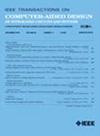安全闭包的放置细化策略
IF 2.9
3区 计算机科学
Q2 COMPUTER SCIENCE, HARDWARE & ARCHITECTURE
IEEE Transactions on Computer-Aided Design of Integrated Circuits and Systems
Pub Date : 2025-03-28
DOI:10.1109/TCAD.2025.3555964
引用次数: 0
摘要
集成电路(ic)的安全封闭是超大规模集成电路(VLSI)领域的一个新兴研究领域。恶意的第三方,被称为“攻击者”,可以使用各种技术来泄漏、改变或操纵电路的逻辑。当针对一个完整的布局时,他们的主要目标通常是插入硬件木马。在这项工作中,我们提出了加强针对硬件木马攻击的放置解决方案的算法。虽然最先进的方法依赖于详尽的放置算法,但我们提出了一种基于聚类的放置方法,可将移动细胞的数量减少多达17%。此外,我们引入了一个细胞运动启发式旨在防止增加的无线。我们的方法减少了78%的易受攻击的放置地点,同时保持对设计性能的最小影响。与其他方法相比,我们的解决方案将移动细胞的数量减少到平均8%,将对波长的影响减少到平均0.5%。本文章由计算机程序翻译,如有差异,请以英文原文为准。
Placement Refinement Strategies for Security Closure
The security closure of integrated circuits (ICs) is an emerging area of research within the very large scale integration (VLSI) community. Malicious third parties, referred to as “attackers,” can employ various techniques to leak, alter, or manipulate the logic of a circuit. When targeting a completed layout, their primary goal is often the insertion of hardware trojans. In this work, we present algorithms that strengthen placement solutions against hardware trojan attacks. While state-of-the-art methods rely on exhaustive placement algorithms, we propose a clustering-based placement approach that reduces the number of moved cells by up to 17%. Additionally, we introduce a cell movement heuristic aimed at preventing increases in wirelength. Our methods reduce vulnerable placement sites by up to 78% while maintaining minimal impact on design performance. Compared to other approaches, our solution decreases the amount of moved cells to an average of 8%, mitigating the impact on wirelength to an average of 0.5%.
求助全文
通过发布文献求助,成功后即可免费获取论文全文。
去求助
来源期刊
CiteScore
5.60
自引率
13.80%
发文量
500
审稿时长
7 months
期刊介绍:
The purpose of this Transactions is to publish papers of interest to individuals in the area of computer-aided design of integrated circuits and systems composed of analog, digital, mixed-signal, optical, or microwave components. The aids include methods, models, algorithms, and man-machine interfaces for system-level, physical and logical design including: planning, synthesis, partitioning, modeling, simulation, layout, verification, testing, hardware-software co-design and documentation of integrated circuit and system designs of all complexities. Design tools and techniques for evaluating and designing integrated circuits and systems for metrics such as performance, power, reliability, testability, and security are a focus.

 求助内容:
求助内容: 应助结果提醒方式:
应助结果提醒方式:


